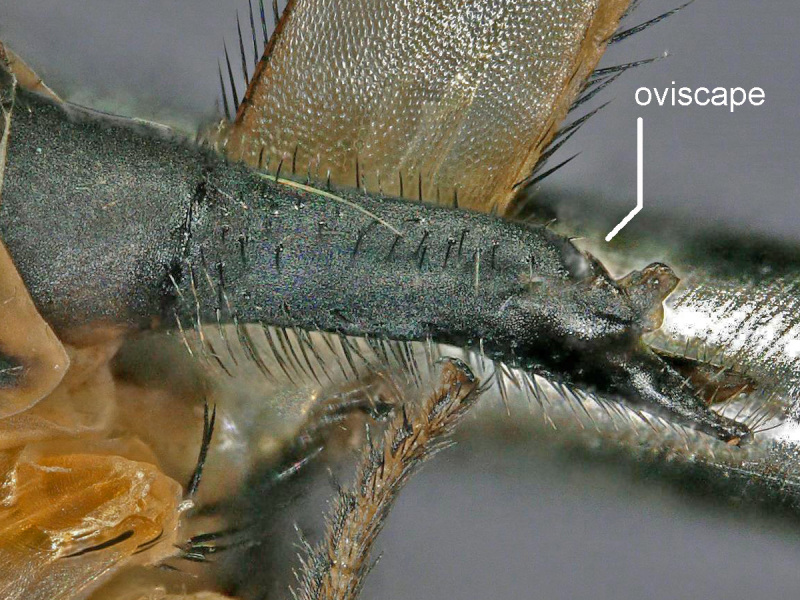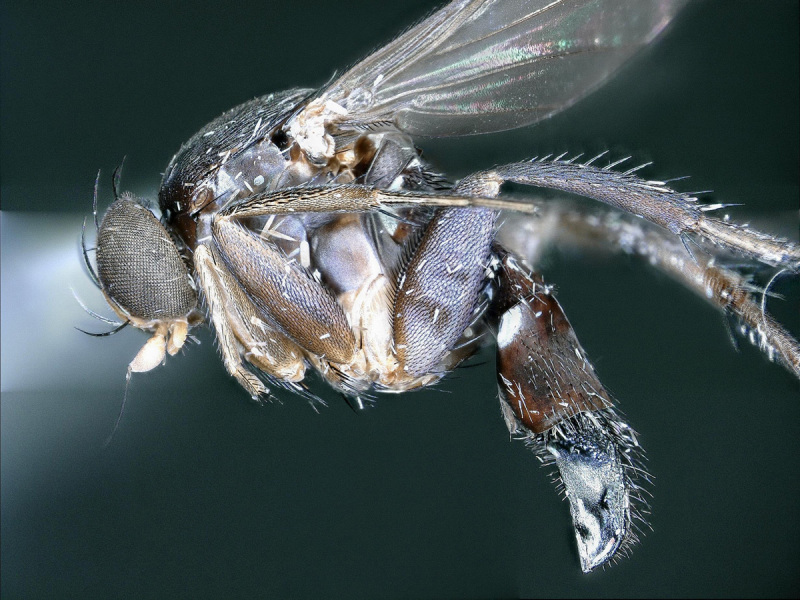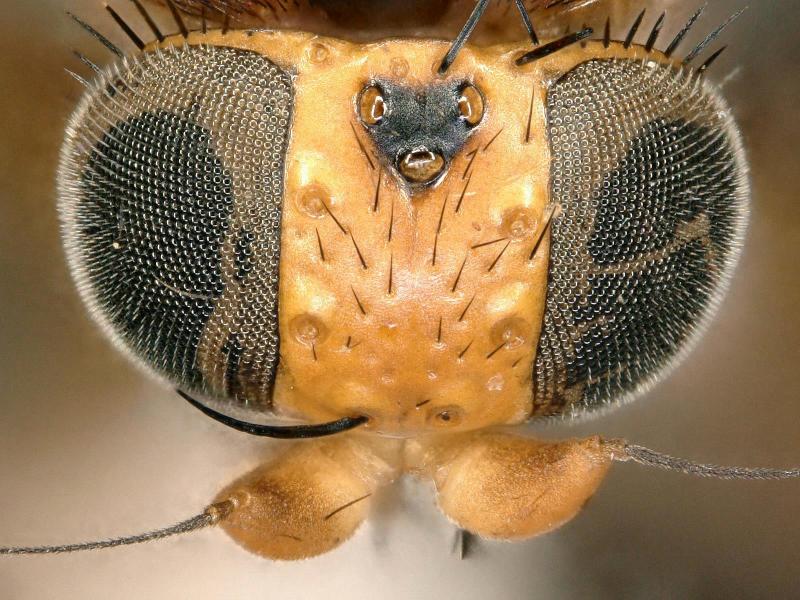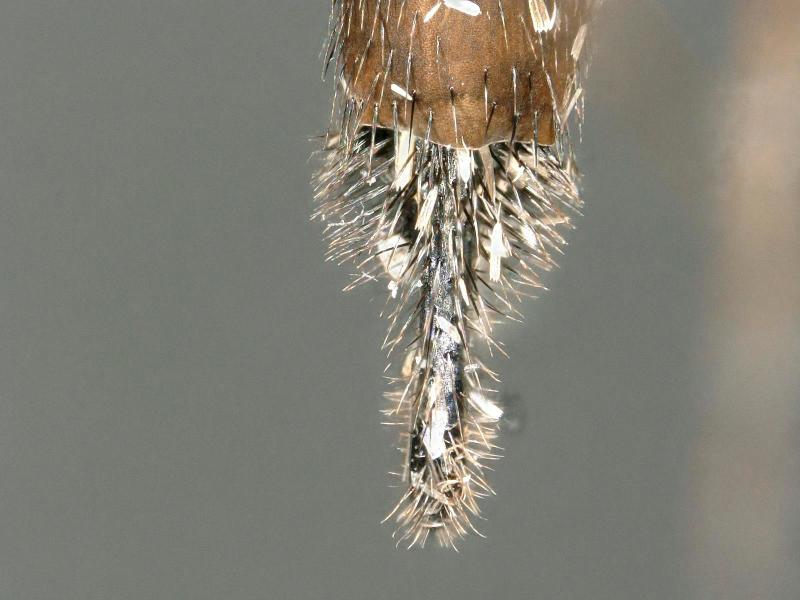Abstract Abstract
Background
The genus Melaloncha is a large group of species of parasitoid phorid flies that attack Hymenoptera, mostly stingless bees (Meliponinae, Apidae) in the Neotropical Region.
New information
Two new Brazilian species, Melaloncha (Melaloncha) peacockorum sp. n. and Melaloncha (Udamochiras) nielsi sp. n., are described and their identification clarified.
Keywords: Phoridae , taxonomy, Neotropical, parasitoid
Introduction
Bee-killing flies of the genus Melaloncha are small (1.5-4.5 mm) fast, agile parasitoids, mostly of stingless bees, bumble bees, and honey bees, but with records also from orchid bees, sweat bees, and vespid wasps (Ament et al. 2013, Brown 2006, Lucia et al. 2013, Lutz and Brown 2013, Ramírez 1982, Wcislo et al. 2004, Brown 2001). Female flies attack hosts by injecting an egg into their body through a membranous area between exoskeleton plates, and the resulting larvae consume and kill them. These flies have been studied in detail recently, with over 150 new species described (Braet 2013, Brown 2004a, Brown 2005, Brown 2006, Brown and Kung 2006, Brown 2004b, Brown 2009, Gonzalez and Brown 2004, Kung 2008) and phylogenetic relationships hypothesized (Brown and Smith 2010, Smith and Brown 2008). A total of 170 species are now recognized (exclusive of the two described in this paper), but it is likely that many more remain to be found.
Materials and methods
Specimens were borrowed from the collections of the Instituto Nacional de Pesquisas da Amazônia, Manaus, Brazil (INPA) and the Universidade de São Paulo, Ribeirão Preto, Brazil. Photographs were taken using a Keyence V5000 digital microscope.
Taxon treatments
Melaloncha (Melaloncha) peacockorum sp. n.
urn:lsid:zoobank.org:act:FE39F86E-1F6C-4A29-8F8E-A8A6B9F4A49C
Materials
Type status: Holotype. Occurrence: catalogNumber: LACM ENT 335990; recordedBy: Amorim, Ribeiro, Berbert; sex: female; lifeStage: adult; Location: country: Brazil; stateProvince: SP; locality: Reserva Biológica Boracéia; verbatimLatitude: 23°39'S; verbatimLongitude: 45°53'W; verbatimCoordinateSystem: degrees minutes; Event: samplingProtocol: Shannon trap; eventDate: 2009-11-20/25; verbatimEventDate: 20-25 November 2009; Record Level: type: PhysicalObject; institutionCode: LACM; collectionCode: ENT; ownerInstitutionCode: MZSP; basisOfRecord: PreservedSpecimen
Description
Female (Figs 1, 2, 3, 4). Body length approximately 3.0 mm. Frons orange, except ocellar triangle black; sculpturing finely reticulate with numerous punctures, most bearing setae. Frons 0.38 head width. Dorsal interfrontal setae absent. Flagellomere 1 orange. Palpus whitish-yellow, with long, black setae. Dorsal postocular setae black; genal and other postocular setae black. Scutum dark (Fig. 3), except anterolaterally yellow. Anterior scutellar seta long, thick, posterior scutellar setae missing from specimen. Pleuron various colors, from yellow to black. Legs yellow. Foretibia with irregular dorsal bare area. Foretarsomeres unmodified. Posterior claw of foreleg not enlarged, claws lobed at base. Costa 0.52 wing length. Wing vein R2+3 absent. Halter yellow. Abdominal tergites black with silvery iridescence. Venter of abdomen yellow. Oviscape black, setose, with rounded, shorter dorsal lobe and longer ventral lobe ending in pair of divergent processes.
Figure 1.

Habitus, left lateral, of Melaloncha (Melaloncha) peacockorum, new species
Figure 2.
Head, anterior, of Melaloncha (Melaloncha) peacockorum new species
Figure 3.

Oviscape, left lateral, of Melaloncha (Melaloncha) peacockorum new species
Figure 4.

Oviscape, dorsal, of Melaloncha (Melaloncha) peacockorum new species
Diagnosis
Dark colored Melaloncha (Melaloncha) with wide, orange, punctate frons, and oviscape with blunt, dorsal, median lobe plus more ventral, bifurcate lobe. In the most recent key to Melaloncha (Melaloncha) species (Brown 2006), M. peacockorum does not successfully pass couplets 5 to 6, which should be modified as follows:
5. Oviscape with apical pair of divergent, narrow setose processes... .5a
- Oviscape lacking setose processes, or, if present, such processes arising ventrally and anterior to apex (as in oviscapes of the M. cingulata group- Brown 2004b)... ..6
5a. Setae of divergent apical processes long, curved, dorsally directed (fig. 32 in Brown 2006); body color mostly yellow..... M. ciliata Brown
- Setae of apical processes shorter, straight, not predominantly dorsally directed; body color mostly dark... . M. peacockorum n. sp.
Etymology
Named for the Peacock family at the request of Jon Peacock, a supporter of the Entomology Department of the Natural History Museum of Los Angeles County (LACM).
Distribution
Brazil.
Ecology
Like most Melaloncha species, this fly is probably a parasitoid of stingless bees. It was collected with a Shannon trap, whose operation I have observed in Brazil. The trap is a large structure consisting of a square of black netting, about 3 m in length on each side, with outer walls of the same material. In construction it is like a large box missing the bottom side. The trap is suspended so that the sides are about 0.3 m above the ground, allowing insects access to the bait. Many insects attempt to escape by flying upwards, rather than using the small opening at ground level, and thus get caught in the top of the trap.
The bait used by the researchers is placed in a shallow pit near the center, and consists of a couple of fish, chicken meat, various vegetables, a bag of oatmeal, some mushrooms, human feces, and urine. This smorgasborg "ripens" over several days and attracts hordes of flies, but also other insects including stingless bees, which are frequently attracted to protein (Roubik 1989). Probably, an aggregation of such bees attracted this fly.
Melaloncha (Udamochiras) nielsi sp. n.
urn:lsid:zoobank.org:act:D20C44D2-00C4-457F-945A-95461C290F15
Materials
Type status: Holotype. Occurrence: catalogNumber: LACM ENT 335989; recordedBy: A. Henriques; sex: female; lifeStage: adult; Location: country: Brazil; stateProvince: AM; verbatimLocality: Manaus, Reserva Ducke, Igarapé Barro Branco; locationRemarks: 20m above forest floor; Event: samplingProtocol: Arm. Suspensa; eventDate: 2004-11-8/18; verbatimEventDate: 08-18.xi.2004; Record Level: institutionID: INPA; ownerInstitutionCode: INPA; basisOfRecord: PreservedSpecimen
Description
Female (Figs 5, 6, 7). Body length approximately 3.8 mm. Frons orange, except ocellar triangle black; sculpturing finely reticulate with numerous lateral punctures, most bearing setae. Frons 0.22 head width. Dorsal interfrontal setae absent. Flagellomere 1 yellow. Palpus yellow, with black setae. Dorsal postocular setae black; genal and other postocular setae black. Thorax mostly black. Anterior scutellar seta long, thin, posterior scutellar seta extremely long. Legs brown, mid- and hind legs dark brown. Foretibia with irregular dorsal bare area. Foretarsomeres missing from both legs. Claws visible only on one hind leg, apically bifurcate. Costa 0.61 wing length. Wing vein R2+3 absent. Halter brown. Abdominal tergites brown with silvery iridescence. Venter of abdomen gray. Oviscape black, with dense, strong black setae basally, dorsally, and ventrally; apically laterally flattened, dorsal surface curved ventrally, ventral surface straight.
Figure 5.

Habitus, left lateral, of Melaloncha (Udamochiras) nielsi sp. n.
Figure 6.
Head, anterior, of Melaloncha (Udamochiras) nielsi sp. n.
Figure 7.
Oviscape, dorsal, of Melaloncha (Udamochiras) nielsi sp. n.
Diagnosis
Large dark species with oviscape densely setose at base, laterally flattened, dorsal surface curved ventrally. In the key to species (Brown 2004a), M. nielsi comes closest to M. valeria Brown, from which it differs by the dense black setae (absent from M. valeria) and greatly compressed structure of the oviscape. It does not resemble any of the more recently described species of Melaloncha (Udamochiras) (Gonzalez and Brown 2004, Brown 2009, Braet 2013).
Etymology
Named for Niels Jensen at the request of Sara Jensen, a supporter of the Entomology Department of the Natural History Museum of Los Angeles County.
Distribution
Brazil
Ecology
Unknown, but presumably parasitoids of stingless bees like most other Melaloncha species.
Supplementary Material
Acknowledgements
I am grateful to Dalton Amorim for helping fund my visit to Brazil.
References
- Ament Danilo César, Freiria Gabriele Antico, da Rocha-Filho Léo Correia, del Lama Marco Antonio, Garófalo Carlos Alberto. A scientific note on the first records of Melaloncha Brues, 1904 (Diptera: Phoridae) parasitizing Euglossini and Centridini bees. http://dx.doi.org/10.1007/s13592-013-0246-1. Apidologie. 2013;45(2):266–268. doi: 10.1007/s13592-013-0246-1. [DOI] [Google Scholar]
- Braet Y. First record of Melaloncha (Udamochiras) bee-killing flies from French Guiana with description of a new species (Diptera: Phoridae) Bulletin de la Société royale belge d’Entomologie. 2013;149:89–91. [Google Scholar]
- Brown Brian V. Beginning to study the bee-killing flies, the parasitoid genus Melaloncha Brues. Phorid Newsletter. 2001;9:1–5. [Google Scholar]
- Brown Brian V. Revision of the subgenus Udamochiras of Melaloncha bee-killing flies (Diptera: Phoridae: Metopininae) http://dx.doi.org/10.1111/j.1096-3642.2004.00086.x. Zoological Journal of the Linnean Society. 2004;140(1):1–42. doi: 10.1111/j.1096-3642.2004.00086.x. [DOI] [Google Scholar]
- Brown Brian V. Revision of the Melaloncha cingulata-Group of Bee-Killing Flies (Diptera: Phoridae) http://dx.doi.org/10.1603/0013-8746(2004)097[0386:rotmco]2.0.co;2. Annals of the Entomological Society of America. 2004;97(3):386–392. doi: 10.1603/0013-8746(2004)097[0386:rotmco]2.0.co;2. [DOI] [Google Scholar]
- Brown Brian. Revision of the Melaloncha (Melaloncha) furcata-group of bee-killing flies (Diptera: Phoridae) http://dx.doi.org/10.1163/187631205788838384. Insect Systematics & Evolution. 2005;36(3):241–258. doi: 10.1163/187631205788838384. [DOI] [Google Scholar]
- Brown Brian V. Revision of the untreated taxa of Melaloncha s. s. bee-killing flies (Diptera: Phoridae). Zootaxa. 2006;1280:1–68. [Google Scholar]
- Brown Brian V., Kung Giar-Ann. Revision of the Melaloncha ungulata-group of bee-killing flies (Diptera: Phoridae) ://ZOOREC:ZOOR14210061350 Contributions in Science (Los Angeles) 2006;507:1–31. [Google Scholar]
- Brown Brian V., Smith Paul T. The bee-killing flies, genus Melaloncha Brues (Diptera: Phoridae): a combined molecular and morphological phylogeny. http://dx.doi.org/10.1111/j.1365-3113.2010.00540.x. Systematic Entomology. 2010;35(4):649–657. doi: 10.1111/j.1365-3113.2010.00540.x. [DOI] [Google Scholar]
- Brown B. V. Three new species of parasitoid Phoridae (Diptera) from the Neotropical Region. Sociobiology. 2009;54:715–722. [Google Scholar]
- Gonzalez Lisa, Brown Brian V. New species and records of Melaloncha (Udamochiras) bee-killing flies (Diptera: Phoridae). Zootaxa. 2004;730:1–14. [Google Scholar]
- Kung Giar-Ann. Two new species of the Melaloncha ungulata group of bee-killing flies (Diptera: Phoridae) ://ZOOREC:ZOOR14411066928 Sociobiology. 2008;51:491–496. [Google Scholar]
- Lucia Mariano, Alvarez Leopoldo J, Abrahamovich Alberto H. First record of Melaloncha (Diptera: Phoridae) parasitoid associated with Bombus (Apidae: Bombini) in Argentina. http://dx.doi.org/10.3896/ibra.1.52.2.15. Journal of Apicultural Research. 2013;52(2):72–73. doi: 10.3896/ibra.1.52.2.15. [DOI] [Google Scholar]
- Lutz M. Ayelen, Brown Brian V. New host association: Polybia scutellaris (Hymenoptera, Vespidae) parasitized by Melaloncha (Diptera, Phoridae) http://dx.doi.org/10.1590/s0085-56262013005000016. Revista Brasileira de Entomologia. 2013;57(2):238–239. doi: 10.1590/s0085-56262013005000016. [DOI] [Google Scholar]
- Ramírez W. Bombus mexicanus Cresson, un hospedante de Melaloncha, moscas par sitas de la abeja de miel en el nuevo mundo. Revista de Biologia Tropical. 1982;30:177. [Google Scholar]
- Roubik D. W. Ecology and natural history of tropical bees. Cambridge University Press; 1989. x + 514. [DOI] [PubMed] [Google Scholar]
- Smith P. T., Brown B. V. Utility of DNA sequences for inferring phylogenetic relationships and associating morphologically dissimilar males and females of the bee-killing flies, genus Melaloncha (Diptera: Phoridae) Annals of the Entomological Society of America. 2008;101:713–721. doi: 10.1603/0013-8746(2008)101[713:UODSFI]2.0.CO;2. [DOI] [Google Scholar]
- Wcislo William T., Arneson Laura, Roesch Kari, Gonzalez Victor, Smith Adam, Fernández Hermógenes. The evolution of nocturnal behaviour in sweat bees, Megalopta genalis and Melaloncha ecuadoria (Hymenoptera: Halictidae): an escape from competitors and enemies? http://dx.doi.org/10.1111/j.1095-8312.2004.00399.x. Biological Journal of the Linnean Society. 2004;83(3):377–387. doi: 10.1111/j.1095-8312.2004.00399.x. [DOI] [Google Scholar]
Associated Data
This section collects any data citations, data availability statements, or supplementary materials included in this article.





